Strategic Marketing Report: Analysis of IKEA's Marketing Strategies
VerifiedAdded on 2020/01/28
|16
|4376
|107
Report
AI Summary
This report provides a comprehensive analysis of IKEA's strategic marketing approach. It begins by outlining the principles of strategic marketing, emphasizing its role in an organization and its relationship with corporate strategy. The report then delves into how IKEA conducts strategic marketing analysis, exploring internal environmental analysis using tools like the McKinsey 7-S framework and resource-based analysis, as well as external environmental analysis through PEST/PESTLE and competitor analysis. The integration of internal and external analyses, particularly through SWOT analysis, is also discussed. Furthermore, the report examines strategic marketing decisions at the corporate level and their influence on business units and functional levels, along with approaches to competitive positioning. Finally, it explores the implementation of various marketing strategies, including marketing communications, to contribute to IKEA's competitive advantage. The report highlights IKEA's customer-centric approach and its use of innovative tools to maintain its market position.
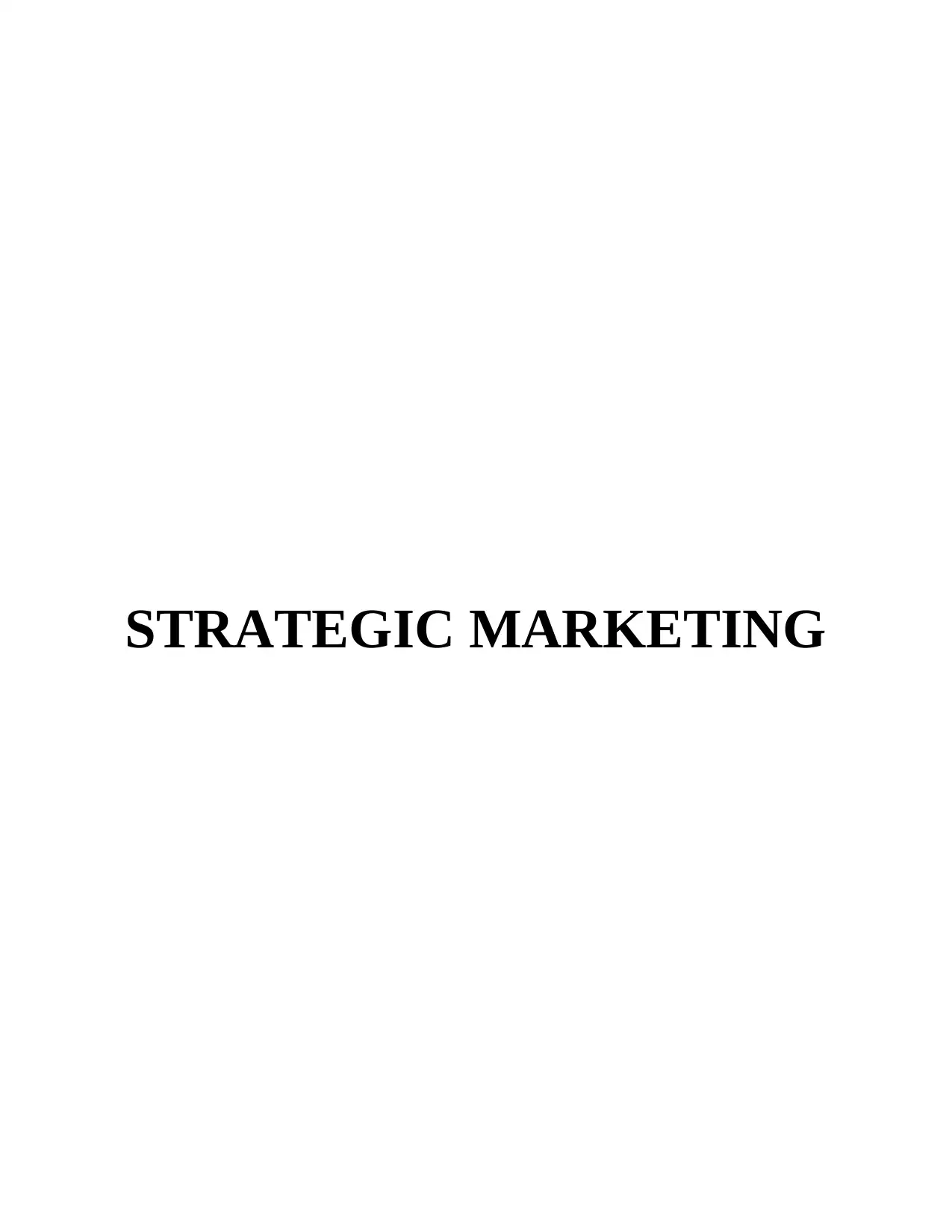
STRATEGIC MARKETING
Paraphrase This Document
Need a fresh take? Get an instant paraphrase of this document with our AI Paraphraser
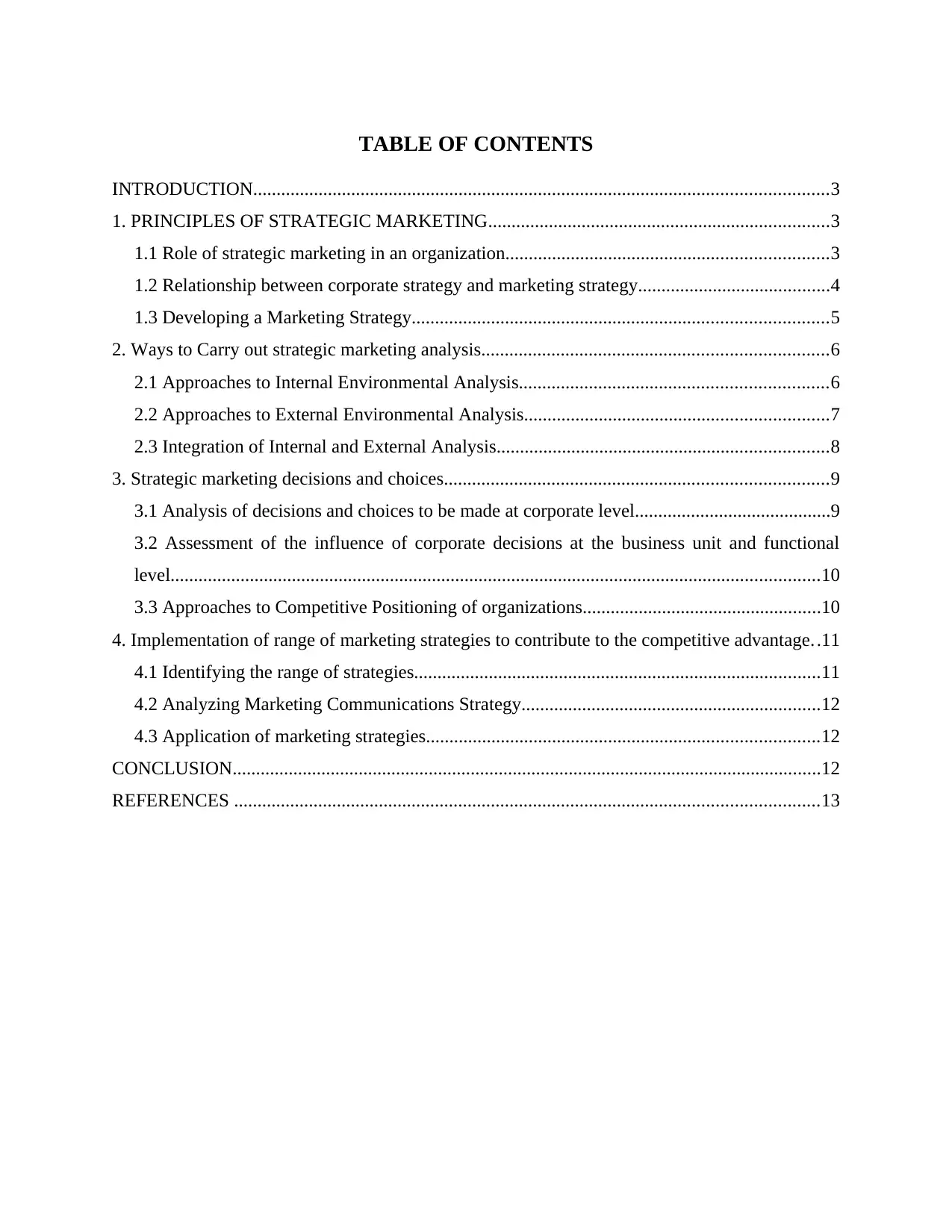
TABLE OF CONTENTS
INTRODUCTION...........................................................................................................................3
1. PRINCIPLES OF STRATEGIC MARKETING.........................................................................3
1.1 Role of strategic marketing in an organization.....................................................................3
1.2 Relationship between corporate strategy and marketing strategy.........................................4
1.3 Developing a Marketing Strategy.........................................................................................5
2. Ways to Carry out strategic marketing analysis..........................................................................6
2.1 Approaches to Internal Environmental Analysis..................................................................6
2.2 Approaches to External Environmental Analysis.................................................................7
2.3 Integration of Internal and External Analysis.......................................................................8
3. Strategic marketing decisions and choices..................................................................................9
3.1 Analysis of decisions and choices to be made at corporate level..........................................9
3.2 Assessment of the influence of corporate decisions at the business unit and functional
level...........................................................................................................................................10
3.3 Approaches to Competitive Positioning of organizations...................................................10
4. Implementation of range of marketing strategies to contribute to the competitive advantage..11
4.1 Identifying the range of strategies.......................................................................................11
4.2 Analyzing Marketing Communications Strategy................................................................12
4.3 Application of marketing strategies....................................................................................12
CONCLUSION..............................................................................................................................12
REFERENCES .............................................................................................................................13
INTRODUCTION...........................................................................................................................3
1. PRINCIPLES OF STRATEGIC MARKETING.........................................................................3
1.1 Role of strategic marketing in an organization.....................................................................3
1.2 Relationship between corporate strategy and marketing strategy.........................................4
1.3 Developing a Marketing Strategy.........................................................................................5
2. Ways to Carry out strategic marketing analysis..........................................................................6
2.1 Approaches to Internal Environmental Analysis..................................................................6
2.2 Approaches to External Environmental Analysis.................................................................7
2.3 Integration of Internal and External Analysis.......................................................................8
3. Strategic marketing decisions and choices..................................................................................9
3.1 Analysis of decisions and choices to be made at corporate level..........................................9
3.2 Assessment of the influence of corporate decisions at the business unit and functional
level...........................................................................................................................................10
3.3 Approaches to Competitive Positioning of organizations...................................................10
4. Implementation of range of marketing strategies to contribute to the competitive advantage..11
4.1 Identifying the range of strategies.......................................................................................11
4.2 Analyzing Marketing Communications Strategy................................................................12
4.3 Application of marketing strategies....................................................................................12
CONCLUSION..............................................................................................................................12
REFERENCES .............................................................................................................................13
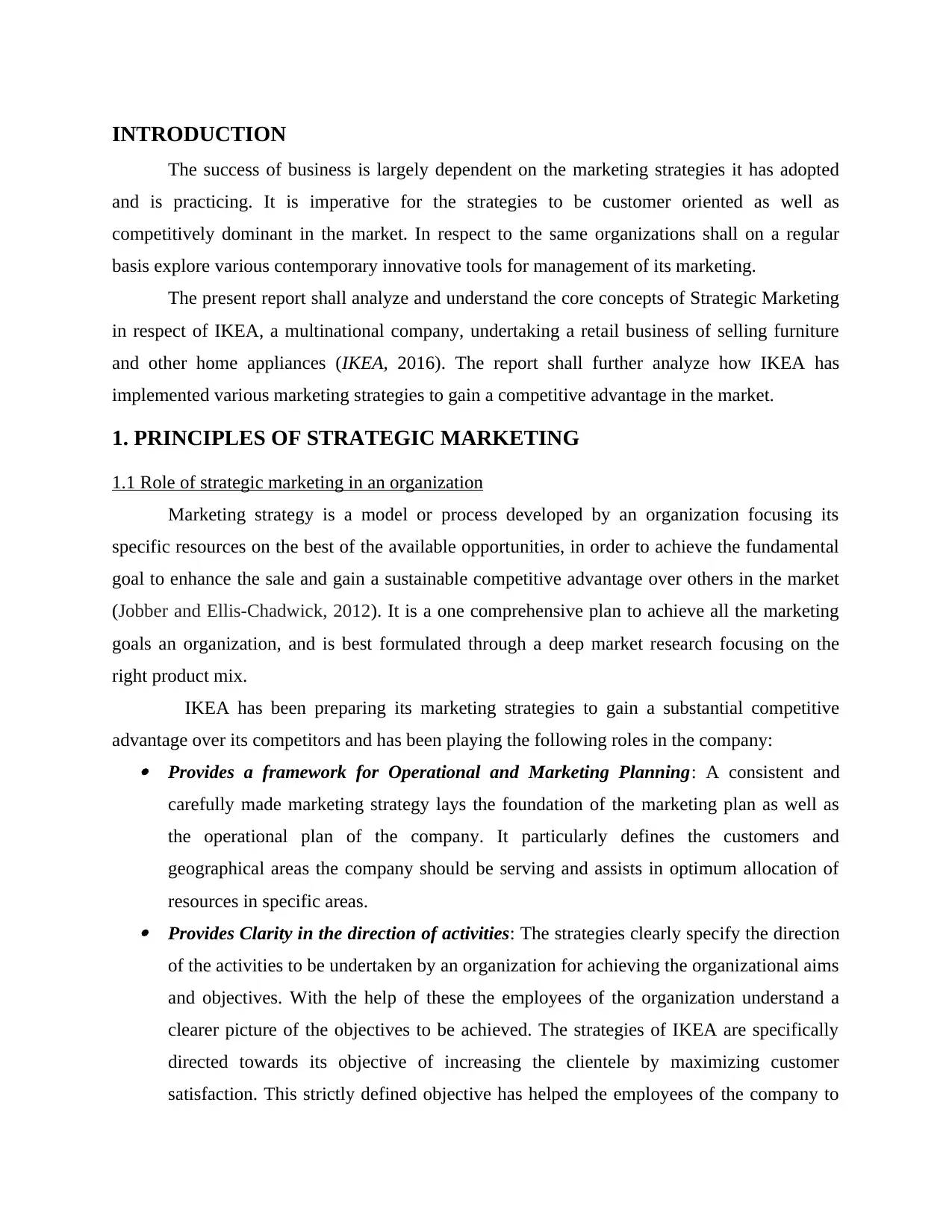
INTRODUCTION
The success of business is largely dependent on the marketing strategies it has adopted
and is practicing. It is imperative for the strategies to be customer oriented as well as
competitively dominant in the market. In respect to the same organizations shall on a regular
basis explore various contemporary innovative tools for management of its marketing.
The present report shall analyze and understand the core concepts of Strategic Marketing
in respect of IKEA, a multinational company, undertaking a retail business of selling furniture
and other home appliances (IKEA, 2016). The report shall further analyze how IKEA has
implemented various marketing strategies to gain a competitive advantage in the market.
1. PRINCIPLES OF STRATEGIC MARKETING
1.1 Role of strategic marketing in an organization
Marketing strategy is a model or process developed by an organization focusing its
specific resources on the best of the available opportunities, in order to achieve the fundamental
goal to enhance the sale and gain a sustainable competitive advantage over others in the market
(Jobber and Ellis-Chadwick, 2012). It is a one comprehensive plan to achieve all the marketing
goals an organization, and is best formulated through a deep market research focusing on the
right product mix.
IKEA has been preparing its marketing strategies to gain a substantial competitive
advantage over its competitors and has been playing the following roles in the company: Provides a framework for Operational and Marketing Planning: A consistent and
carefully made marketing strategy lays the foundation of the marketing plan as well as
the operational plan of the company. It particularly defines the customers and
geographical areas the company should be serving and assists in optimum allocation of
resources in specific areas. Provides Clarity in the direction of activities: The strategies clearly specify the direction
of the activities to be undertaken by an organization for achieving the organizational aims
and objectives. With the help of these the employees of the organization understand a
clearer picture of the objectives to be achieved. The strategies of IKEA are specifically
directed towards its objective of increasing the clientele by maximizing customer
satisfaction. This strictly defined objective has helped the employees of the company to
The success of business is largely dependent on the marketing strategies it has adopted
and is practicing. It is imperative for the strategies to be customer oriented as well as
competitively dominant in the market. In respect to the same organizations shall on a regular
basis explore various contemporary innovative tools for management of its marketing.
The present report shall analyze and understand the core concepts of Strategic Marketing
in respect of IKEA, a multinational company, undertaking a retail business of selling furniture
and other home appliances (IKEA, 2016). The report shall further analyze how IKEA has
implemented various marketing strategies to gain a competitive advantage in the market.
1. PRINCIPLES OF STRATEGIC MARKETING
1.1 Role of strategic marketing in an organization
Marketing strategy is a model or process developed by an organization focusing its
specific resources on the best of the available opportunities, in order to achieve the fundamental
goal to enhance the sale and gain a sustainable competitive advantage over others in the market
(Jobber and Ellis-Chadwick, 2012). It is a one comprehensive plan to achieve all the marketing
goals an organization, and is best formulated through a deep market research focusing on the
right product mix.
IKEA has been preparing its marketing strategies to gain a substantial competitive
advantage over its competitors and has been playing the following roles in the company: Provides a framework for Operational and Marketing Planning: A consistent and
carefully made marketing strategy lays the foundation of the marketing plan as well as
the operational plan of the company. It particularly defines the customers and
geographical areas the company should be serving and assists in optimum allocation of
resources in specific areas. Provides Clarity in the direction of activities: The strategies clearly specify the direction
of the activities to be undertaken by an organization for achieving the organizational aims
and objectives. With the help of these the employees of the organization understand a
clearer picture of the objectives to be achieved. The strategies of IKEA are specifically
directed towards its objective of increasing the clientele by maximizing customer
satisfaction. This strictly defined objective has helped the employees of the company to
You're viewing a preview
Unlock full access by subscribing today!
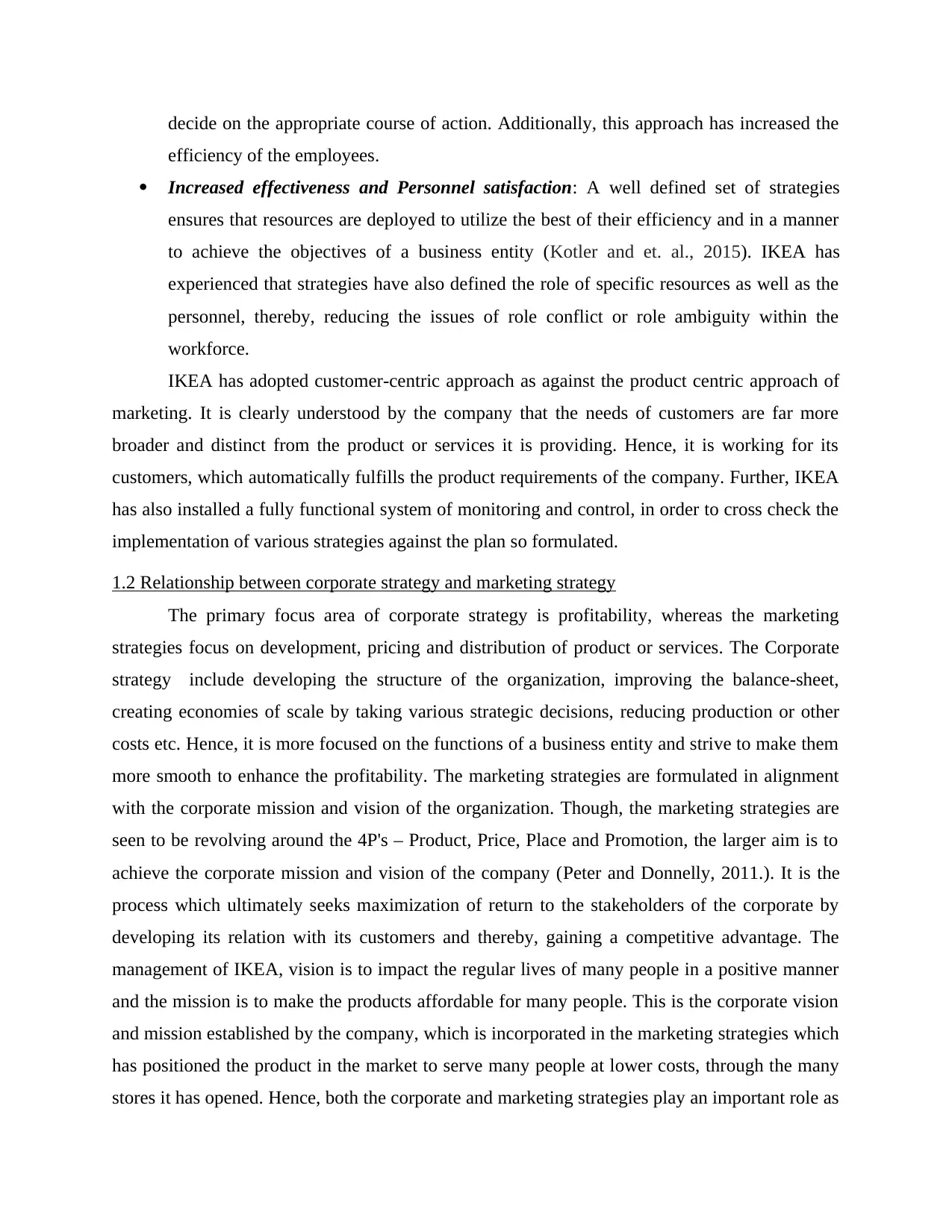
decide on the appropriate course of action. Additionally, this approach has increased the
efficiency of the employees.
Increased effectiveness and Personnel satisfaction: A well defined set of strategies
ensures that resources are deployed to utilize the best of their efficiency and in a manner
to achieve the objectives of a business entity (Kotler and et. al., 2015). IKEA has
experienced that strategies have also defined the role of specific resources as well as the
personnel, thereby, reducing the issues of role conflict or role ambiguity within the
workforce.
IKEA has adopted customer-centric approach as against the product centric approach of
marketing. It is clearly understood by the company that the needs of customers are far more
broader and distinct from the product or services it is providing. Hence, it is working for its
customers, which automatically fulfills the product requirements of the company. Further, IKEA
has also installed a fully functional system of monitoring and control, in order to cross check the
implementation of various strategies against the plan so formulated.
1.2 Relationship between corporate strategy and marketing strategy
The primary focus area of corporate strategy is profitability, whereas the marketing
strategies focus on development, pricing and distribution of product or services. The Corporate
strategy include developing the structure of the organization, improving the balance-sheet,
creating economies of scale by taking various strategic decisions, reducing production or other
costs etc. Hence, it is more focused on the functions of a business entity and strive to make them
more smooth to enhance the profitability. The marketing strategies are formulated in alignment
with the corporate mission and vision of the organization. Though, the marketing strategies are
seen to be revolving around the 4P's – Product, Price, Place and Promotion, the larger aim is to
achieve the corporate mission and vision of the company (Peter and Donnelly, 2011.). It is the
process which ultimately seeks maximization of return to the stakeholders of the corporate by
developing its relation with its customers and thereby, gaining a competitive advantage. The
management of IKEA, vision is to impact the regular lives of many people in a positive manner
and the mission is to make the products affordable for many people. This is the corporate vision
and mission established by the company, which is incorporated in the marketing strategies which
has positioned the product in the market to serve many people at lower costs, through the many
stores it has opened. Hence, both the corporate and marketing strategies play an important role as
efficiency of the employees.
Increased effectiveness and Personnel satisfaction: A well defined set of strategies
ensures that resources are deployed to utilize the best of their efficiency and in a manner
to achieve the objectives of a business entity (Kotler and et. al., 2015). IKEA has
experienced that strategies have also defined the role of specific resources as well as the
personnel, thereby, reducing the issues of role conflict or role ambiguity within the
workforce.
IKEA has adopted customer-centric approach as against the product centric approach of
marketing. It is clearly understood by the company that the needs of customers are far more
broader and distinct from the product or services it is providing. Hence, it is working for its
customers, which automatically fulfills the product requirements of the company. Further, IKEA
has also installed a fully functional system of monitoring and control, in order to cross check the
implementation of various strategies against the plan so formulated.
1.2 Relationship between corporate strategy and marketing strategy
The primary focus area of corporate strategy is profitability, whereas the marketing
strategies focus on development, pricing and distribution of product or services. The Corporate
strategy include developing the structure of the organization, improving the balance-sheet,
creating economies of scale by taking various strategic decisions, reducing production or other
costs etc. Hence, it is more focused on the functions of a business entity and strive to make them
more smooth to enhance the profitability. The marketing strategies are formulated in alignment
with the corporate mission and vision of the organization. Though, the marketing strategies are
seen to be revolving around the 4P's – Product, Price, Place and Promotion, the larger aim is to
achieve the corporate mission and vision of the company (Peter and Donnelly, 2011.). It is the
process which ultimately seeks maximization of return to the stakeholders of the corporate by
developing its relation with its customers and thereby, gaining a competitive advantage. The
management of IKEA, vision is to impact the regular lives of many people in a positive manner
and the mission is to make the products affordable for many people. This is the corporate vision
and mission established by the company, which is incorporated in the marketing strategies which
has positioned the product in the market to serve many people at lower costs, through the many
stores it has opened. Hence, both the corporate and marketing strategies play an important role as
Paraphrase This Document
Need a fresh take? Get an instant paraphrase of this document with our AI Paraphraser
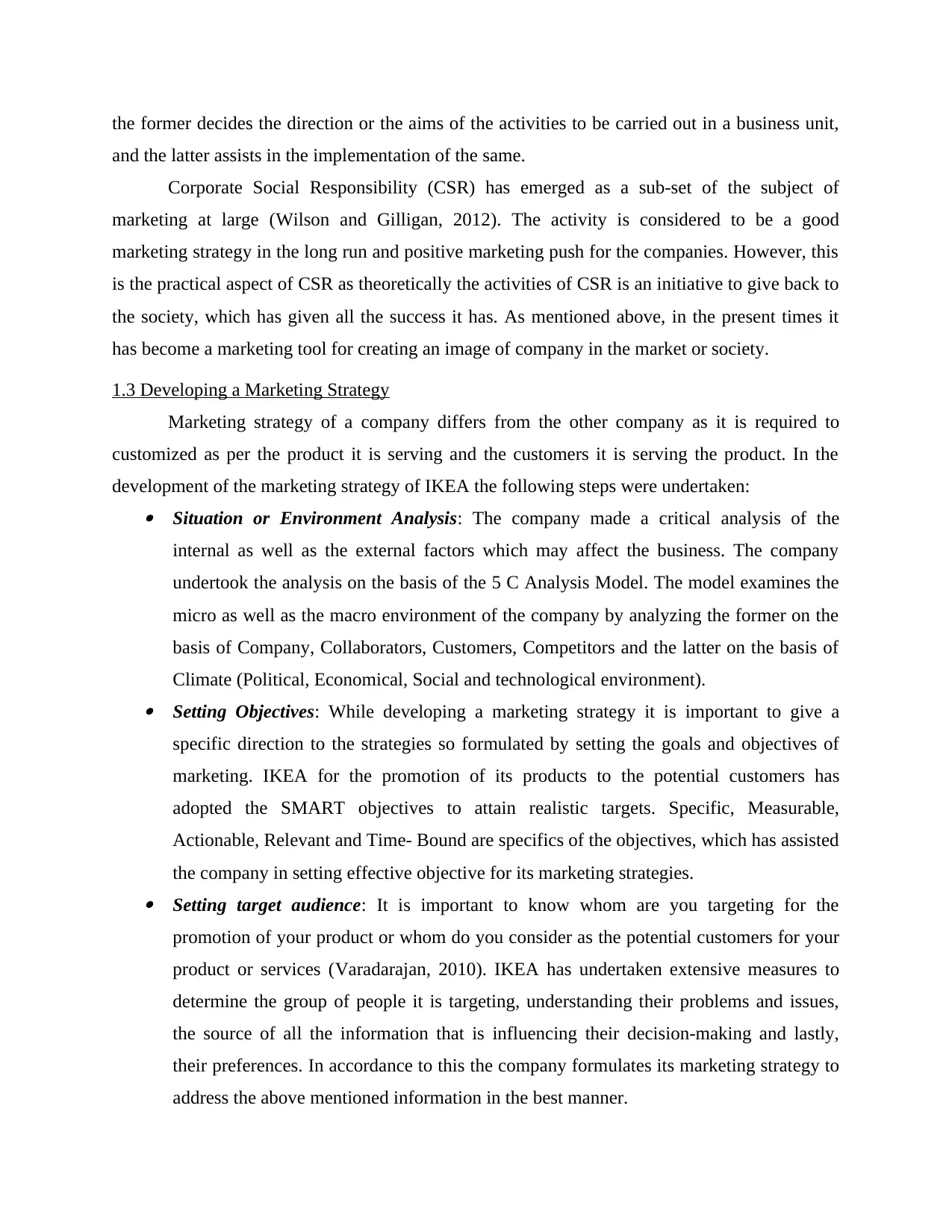
the former decides the direction or the aims of the activities to be carried out in a business unit,
and the latter assists in the implementation of the same.
Corporate Social Responsibility (CSR) has emerged as a sub-set of the subject of
marketing at large (Wilson and Gilligan, 2012). The activity is considered to be a good
marketing strategy in the long run and positive marketing push for the companies. However, this
is the practical aspect of CSR as theoretically the activities of CSR is an initiative to give back to
the society, which has given all the success it has. As mentioned above, in the present times it
has become a marketing tool for creating an image of company in the market or society.
1.3 Developing a Marketing Strategy
Marketing strategy of a company differs from the other company as it is required to
customized as per the product it is serving and the customers it is serving the product. In the
development of the marketing strategy of IKEA the following steps were undertaken: Situation or Environment Analysis: The company made a critical analysis of the
internal as well as the external factors which may affect the business. The company
undertook the analysis on the basis of the 5 C Analysis Model. The model examines the
micro as well as the macro environment of the company by analyzing the former on the
basis of Company, Collaborators, Customers, Competitors and the latter on the basis of
Climate (Political, Economical, Social and technological environment). Setting Objectives: While developing a marketing strategy it is important to give a
specific direction to the strategies so formulated by setting the goals and objectives of
marketing. IKEA for the promotion of its products to the potential customers has
adopted the SMART objectives to attain realistic targets. Specific, Measurable,
Actionable, Relevant and Time- Bound are specifics of the objectives, which has assisted
the company in setting effective objective for its marketing strategies. Setting target audience: It is important to know whom are you targeting for the
promotion of your product or whom do you consider as the potential customers for your
product or services (Varadarajan, 2010). IKEA has undertaken extensive measures to
determine the group of people it is targeting, understanding their problems and issues,
the source of all the information that is influencing their decision-making and lastly,
their preferences. In accordance to this the company formulates its marketing strategy to
address the above mentioned information in the best manner.
and the latter assists in the implementation of the same.
Corporate Social Responsibility (CSR) has emerged as a sub-set of the subject of
marketing at large (Wilson and Gilligan, 2012). The activity is considered to be a good
marketing strategy in the long run and positive marketing push for the companies. However, this
is the practical aspect of CSR as theoretically the activities of CSR is an initiative to give back to
the society, which has given all the success it has. As mentioned above, in the present times it
has become a marketing tool for creating an image of company in the market or society.
1.3 Developing a Marketing Strategy
Marketing strategy of a company differs from the other company as it is required to
customized as per the product it is serving and the customers it is serving the product. In the
development of the marketing strategy of IKEA the following steps were undertaken: Situation or Environment Analysis: The company made a critical analysis of the
internal as well as the external factors which may affect the business. The company
undertook the analysis on the basis of the 5 C Analysis Model. The model examines the
micro as well as the macro environment of the company by analyzing the former on the
basis of Company, Collaborators, Customers, Competitors and the latter on the basis of
Climate (Political, Economical, Social and technological environment). Setting Objectives: While developing a marketing strategy it is important to give a
specific direction to the strategies so formulated by setting the goals and objectives of
marketing. IKEA for the promotion of its products to the potential customers has
adopted the SMART objectives to attain realistic targets. Specific, Measurable,
Actionable, Relevant and Time- Bound are specifics of the objectives, which has assisted
the company in setting effective objective for its marketing strategies. Setting target audience: It is important to know whom are you targeting for the
promotion of your product or whom do you consider as the potential customers for your
product or services (Varadarajan, 2010). IKEA has undertaken extensive measures to
determine the group of people it is targeting, understanding their problems and issues,
the source of all the information that is influencing their decision-making and lastly,
their preferences. In accordance to this the company formulates its marketing strategy to
address the above mentioned information in the best manner.
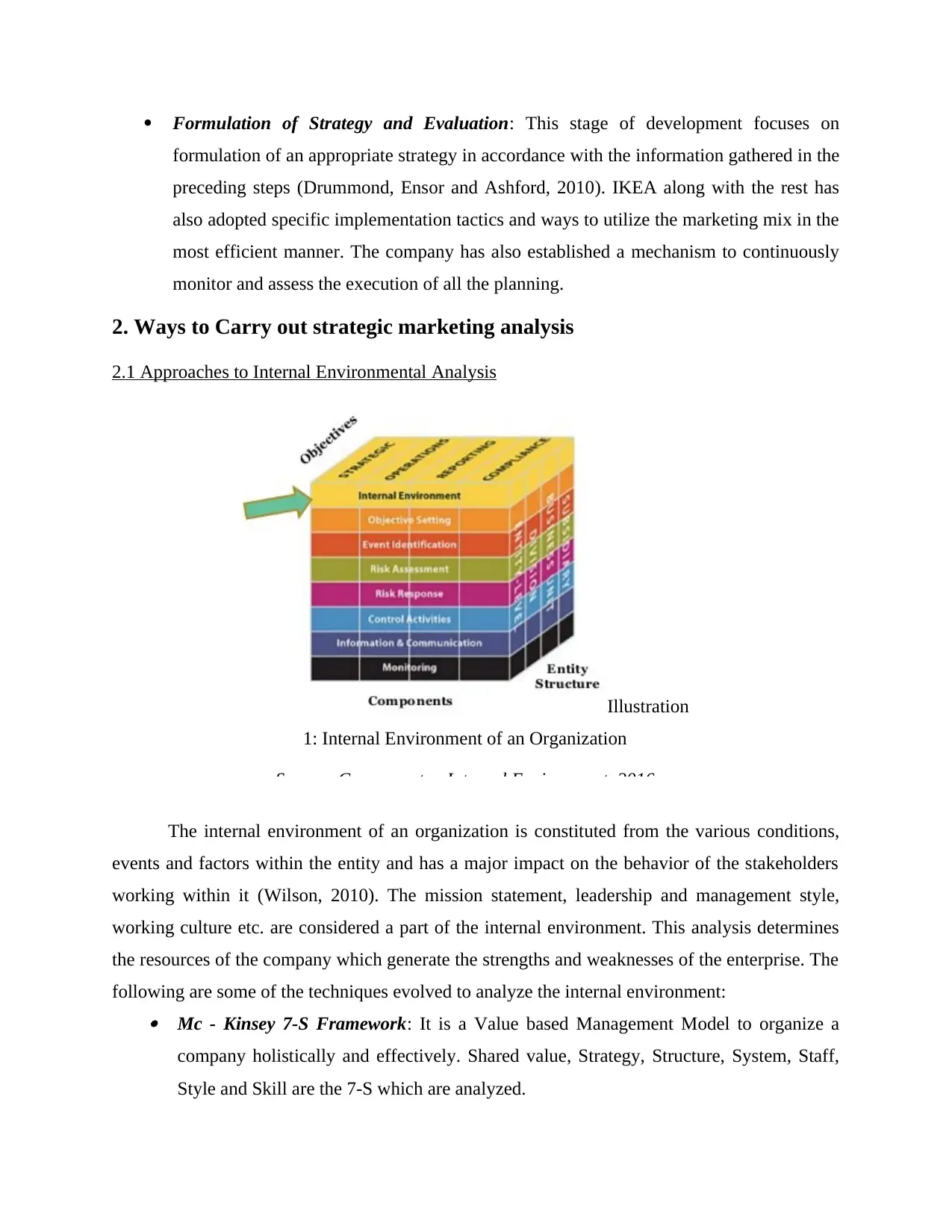
Formulation of Strategy and Evaluation: This stage of development focuses on
formulation of an appropriate strategy in accordance with the information gathered in the
preceding steps (Drummond, Ensor and Ashford, 2010). IKEA along with the rest has
also adopted specific implementation tactics and ways to utilize the marketing mix in the
most efficient manner. The company has also established a mechanism to continuously
monitor and assess the execution of all the planning.
2. Ways to Carry out strategic marketing analysis
2.1 Approaches to Internal Environmental Analysis
The internal environment of an organization is constituted from the various conditions,
events and factors within the entity and has a major impact on the behavior of the stakeholders
working within it (Wilson, 2010). The mission statement, leadership and management style,
working culture etc. are considered a part of the internal environment. This analysis determines
the resources of the company which generate the strengths and weaknesses of the enterprise. The
following are some of the techniques evolved to analyze the internal environment: Mc - Kinsey 7-S Framework: It is a Value based Management Model to organize a
company holistically and effectively. Shared value, Strategy, Structure, System, Staff,
Style and Skill are the 7-S which are analyzed.
Illustration
1: Internal Environment of an Organization
Source: Components - Internal Environment, 2016
formulation of an appropriate strategy in accordance with the information gathered in the
preceding steps (Drummond, Ensor and Ashford, 2010). IKEA along with the rest has
also adopted specific implementation tactics and ways to utilize the marketing mix in the
most efficient manner. The company has also established a mechanism to continuously
monitor and assess the execution of all the planning.
2. Ways to Carry out strategic marketing analysis
2.1 Approaches to Internal Environmental Analysis
The internal environment of an organization is constituted from the various conditions,
events and factors within the entity and has a major impact on the behavior of the stakeholders
working within it (Wilson, 2010). The mission statement, leadership and management style,
working culture etc. are considered a part of the internal environment. This analysis determines
the resources of the company which generate the strengths and weaknesses of the enterprise. The
following are some of the techniques evolved to analyze the internal environment: Mc - Kinsey 7-S Framework: It is a Value based Management Model to organize a
company holistically and effectively. Shared value, Strategy, Structure, System, Staff,
Style and Skill are the 7-S which are analyzed.
Illustration
1: Internal Environment of an Organization
Source: Components - Internal Environment, 2016
You're viewing a preview
Unlock full access by subscribing today!
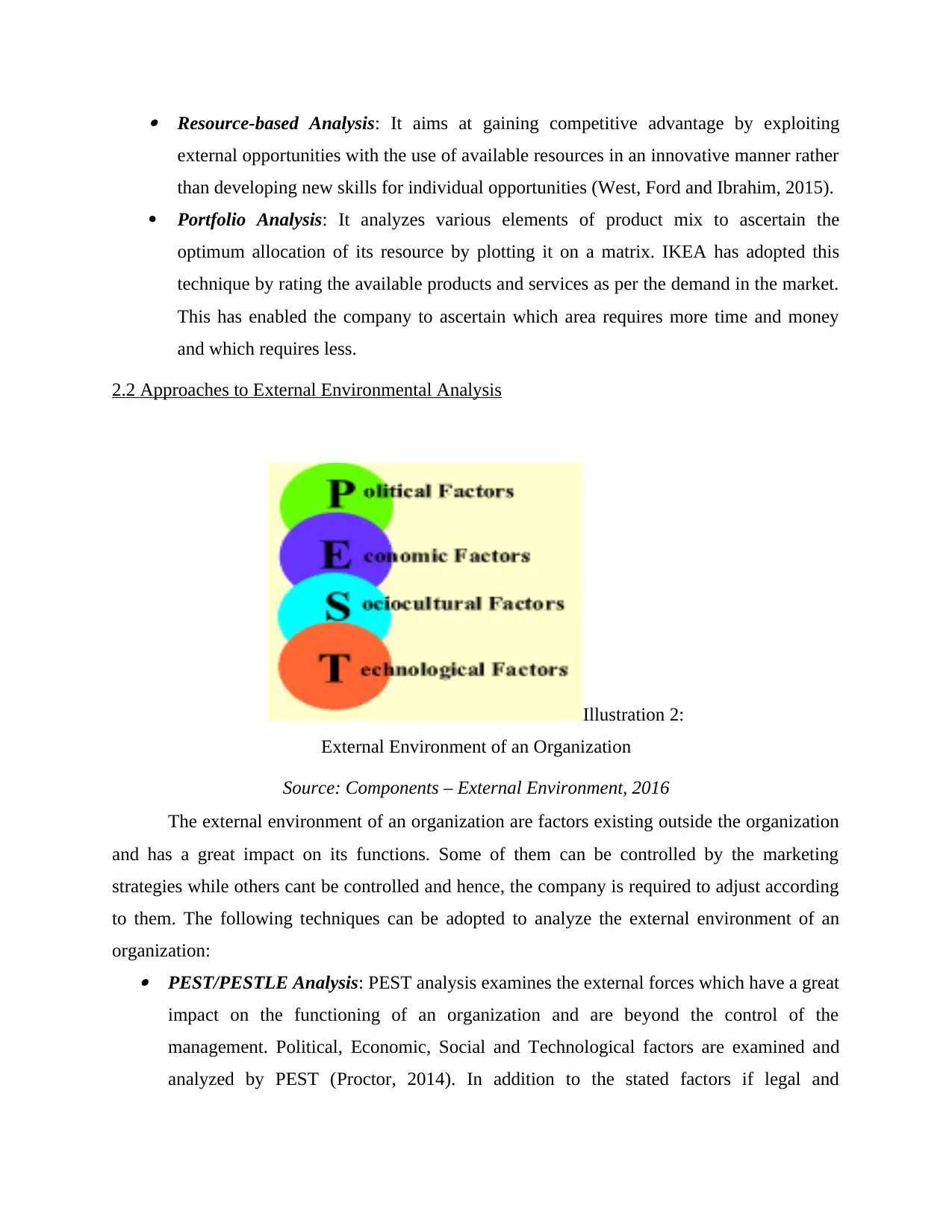
Resource-based Analysis: It aims at gaining competitive advantage by exploiting
external opportunities with the use of available resources in an innovative manner rather
than developing new skills for individual opportunities (West, Ford and Ibrahim, 2015).
Portfolio Analysis: It analyzes various elements of product mix to ascertain the
optimum allocation of its resource by plotting it on a matrix. IKEA has adopted this
technique by rating the available products and services as per the demand in the market.
This has enabled the company to ascertain which area requires more time and money
and which requires less.
2.2 Approaches to External Environmental Analysis
The external environment of an organization are factors existing outside the organization
and has a great impact on its functions. Some of them can be controlled by the marketing
strategies while others cant be controlled and hence, the company is required to adjust according
to them. The following techniques can be adopted to analyze the external environment of an
organization: PEST/PESTLE Analysis: PEST analysis examines the external forces which have a great
impact on the functioning of an organization and are beyond the control of the
management. Political, Economic, Social and Technological factors are examined and
analyzed by PEST (Proctor, 2014). In addition to the stated factors if legal and
Illustration 2:
External Environment of an Organization
Source: Components – External Environment, 2016
external opportunities with the use of available resources in an innovative manner rather
than developing new skills for individual opportunities (West, Ford and Ibrahim, 2015).
Portfolio Analysis: It analyzes various elements of product mix to ascertain the
optimum allocation of its resource by plotting it on a matrix. IKEA has adopted this
technique by rating the available products and services as per the demand in the market.
This has enabled the company to ascertain which area requires more time and money
and which requires less.
2.2 Approaches to External Environmental Analysis
The external environment of an organization are factors existing outside the organization
and has a great impact on its functions. Some of them can be controlled by the marketing
strategies while others cant be controlled and hence, the company is required to adjust according
to them. The following techniques can be adopted to analyze the external environment of an
organization: PEST/PESTLE Analysis: PEST analysis examines the external forces which have a great
impact on the functioning of an organization and are beyond the control of the
management. Political, Economic, Social and Technological factors are examined and
analyzed by PEST (Proctor, 2014). In addition to the stated factors if legal and
Illustration 2:
External Environment of an Organization
Source: Components – External Environment, 2016
Paraphrase This Document
Need a fresh take? Get an instant paraphrase of this document with our AI Paraphraser
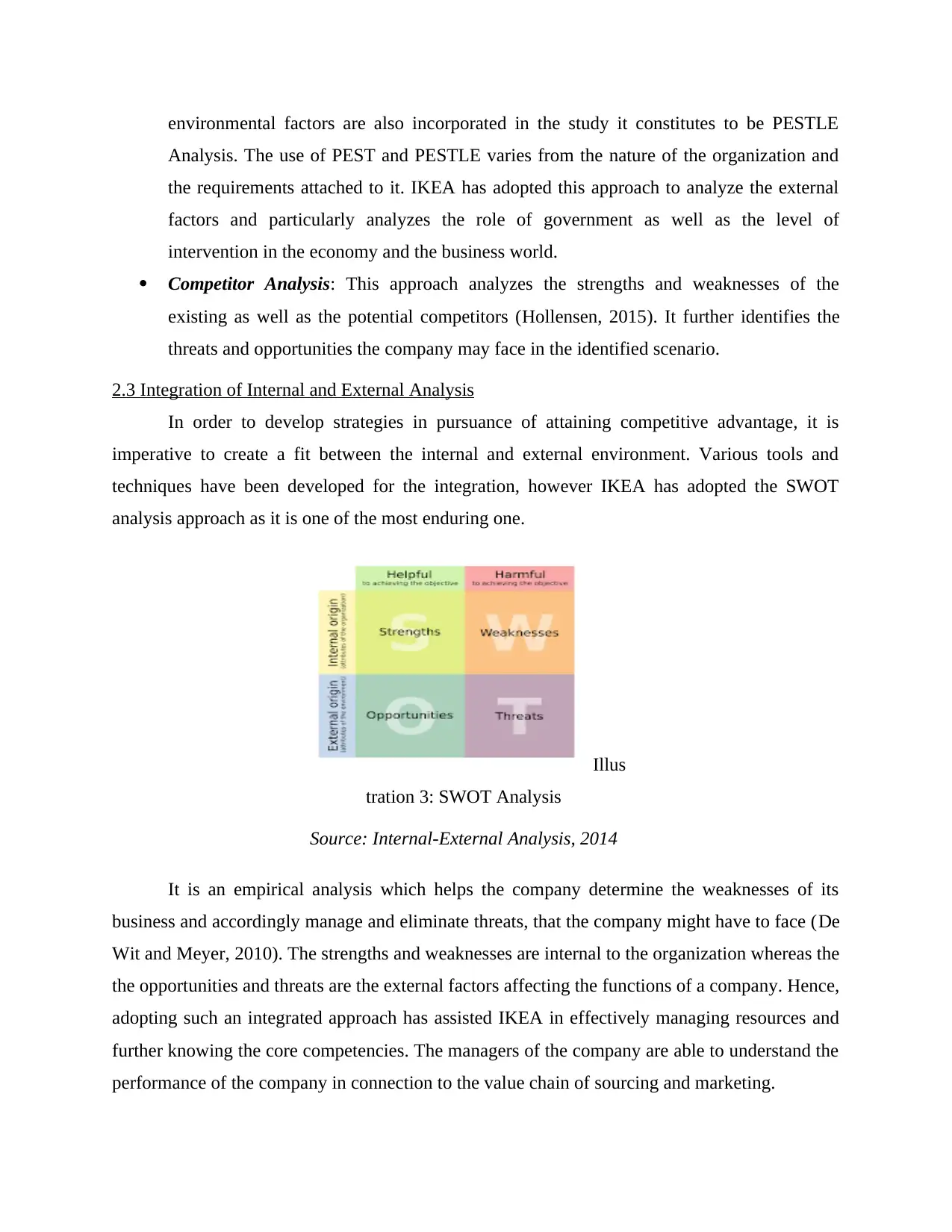
environmental factors are also incorporated in the study it constitutes to be PESTLE
Analysis. The use of PEST and PESTLE varies from the nature of the organization and
the requirements attached to it. IKEA has adopted this approach to analyze the external
factors and particularly analyzes the role of government as well as the level of
intervention in the economy and the business world.
Competitor Analysis: This approach analyzes the strengths and weaknesses of the
existing as well as the potential competitors (Hollensen, 2015). It further identifies the
threats and opportunities the company may face in the identified scenario.
2.3 Integration of Internal and External Analysis
In order to develop strategies in pursuance of attaining competitive advantage, it is
imperative to create a fit between the internal and external environment. Various tools and
techniques have been developed for the integration, however IKEA has adopted the SWOT
analysis approach as it is one of the most enduring one.
It is an empirical analysis which helps the company determine the weaknesses of its
business and accordingly manage and eliminate threats, that the company might have to face (De
Wit and Meyer, 2010). The strengths and weaknesses are internal to the organization whereas the
the opportunities and threats are the external factors affecting the functions of a company. Hence,
adopting such an integrated approach has assisted IKEA in effectively managing resources and
further knowing the core competencies. The managers of the company are able to understand the
performance of the company in connection to the value chain of sourcing and marketing.
Illus
tration 3: SWOT Analysis
Source: Internal-External Analysis, 2014
Analysis. The use of PEST and PESTLE varies from the nature of the organization and
the requirements attached to it. IKEA has adopted this approach to analyze the external
factors and particularly analyzes the role of government as well as the level of
intervention in the economy and the business world.
Competitor Analysis: This approach analyzes the strengths and weaknesses of the
existing as well as the potential competitors (Hollensen, 2015). It further identifies the
threats and opportunities the company may face in the identified scenario.
2.3 Integration of Internal and External Analysis
In order to develop strategies in pursuance of attaining competitive advantage, it is
imperative to create a fit between the internal and external environment. Various tools and
techniques have been developed for the integration, however IKEA has adopted the SWOT
analysis approach as it is one of the most enduring one.
It is an empirical analysis which helps the company determine the weaknesses of its
business and accordingly manage and eliminate threats, that the company might have to face (De
Wit and Meyer, 2010). The strengths and weaknesses are internal to the organization whereas the
the opportunities and threats are the external factors affecting the functions of a company. Hence,
adopting such an integrated approach has assisted IKEA in effectively managing resources and
further knowing the core competencies. The managers of the company are able to understand the
performance of the company in connection to the value chain of sourcing and marketing.
Illus
tration 3: SWOT Analysis
Source: Internal-External Analysis, 2014
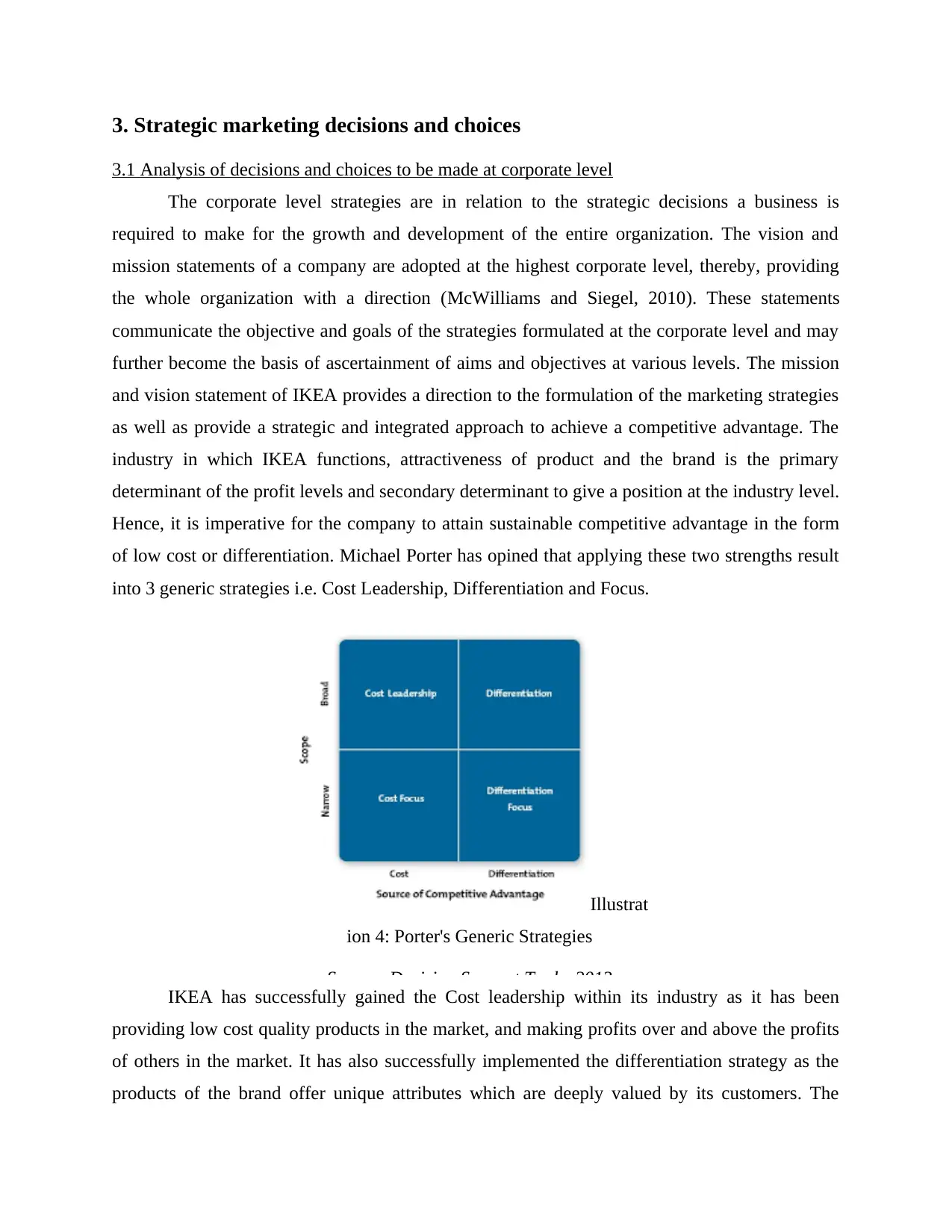
3. Strategic marketing decisions and choices
3.1 Analysis of decisions and choices to be made at corporate level
The corporate level strategies are in relation to the strategic decisions a business is
required to make for the growth and development of the entire organization. The vision and
mission statements of a company are adopted at the highest corporate level, thereby, providing
the whole organization with a direction (McWilliams and Siegel, 2010). These statements
communicate the objective and goals of the strategies formulated at the corporate level and may
further become the basis of ascertainment of aims and objectives at various levels. The mission
and vision statement of IKEA provides a direction to the formulation of the marketing strategies
as well as provide a strategic and integrated approach to achieve a competitive advantage. The
industry in which IKEA functions, attractiveness of product and the brand is the primary
determinant of the profit levels and secondary determinant to give a position at the industry level.
Hence, it is imperative for the company to attain sustainable competitive advantage in the form
of low cost or differentiation. Michael Porter has opined that applying these two strengths result
into 3 generic strategies i.e. Cost Leadership, Differentiation and Focus.
IKEA has successfully gained the Cost leadership within its industry as it has been
providing low cost quality products in the market, and making profits over and above the profits
of others in the market. It has also successfully implemented the differentiation strategy as the
products of the brand offer unique attributes which are deeply valued by its customers. The
Illustrat
ion 4: Porter's Generic Strategies
Source: Decision Support Tools, 2013
3.1 Analysis of decisions and choices to be made at corporate level
The corporate level strategies are in relation to the strategic decisions a business is
required to make for the growth and development of the entire organization. The vision and
mission statements of a company are adopted at the highest corporate level, thereby, providing
the whole organization with a direction (McWilliams and Siegel, 2010). These statements
communicate the objective and goals of the strategies formulated at the corporate level and may
further become the basis of ascertainment of aims and objectives at various levels. The mission
and vision statement of IKEA provides a direction to the formulation of the marketing strategies
as well as provide a strategic and integrated approach to achieve a competitive advantage. The
industry in which IKEA functions, attractiveness of product and the brand is the primary
determinant of the profit levels and secondary determinant to give a position at the industry level.
Hence, it is imperative for the company to attain sustainable competitive advantage in the form
of low cost or differentiation. Michael Porter has opined that applying these two strengths result
into 3 generic strategies i.e. Cost Leadership, Differentiation and Focus.
IKEA has successfully gained the Cost leadership within its industry as it has been
providing low cost quality products in the market, and making profits over and above the profits
of others in the market. It has also successfully implemented the differentiation strategy as the
products of the brand offer unique attributes which are deeply valued by its customers. The
Illustrat
ion 4: Porter's Generic Strategies
Source: Decision Support Tools, 2013
You're viewing a preview
Unlock full access by subscribing today!
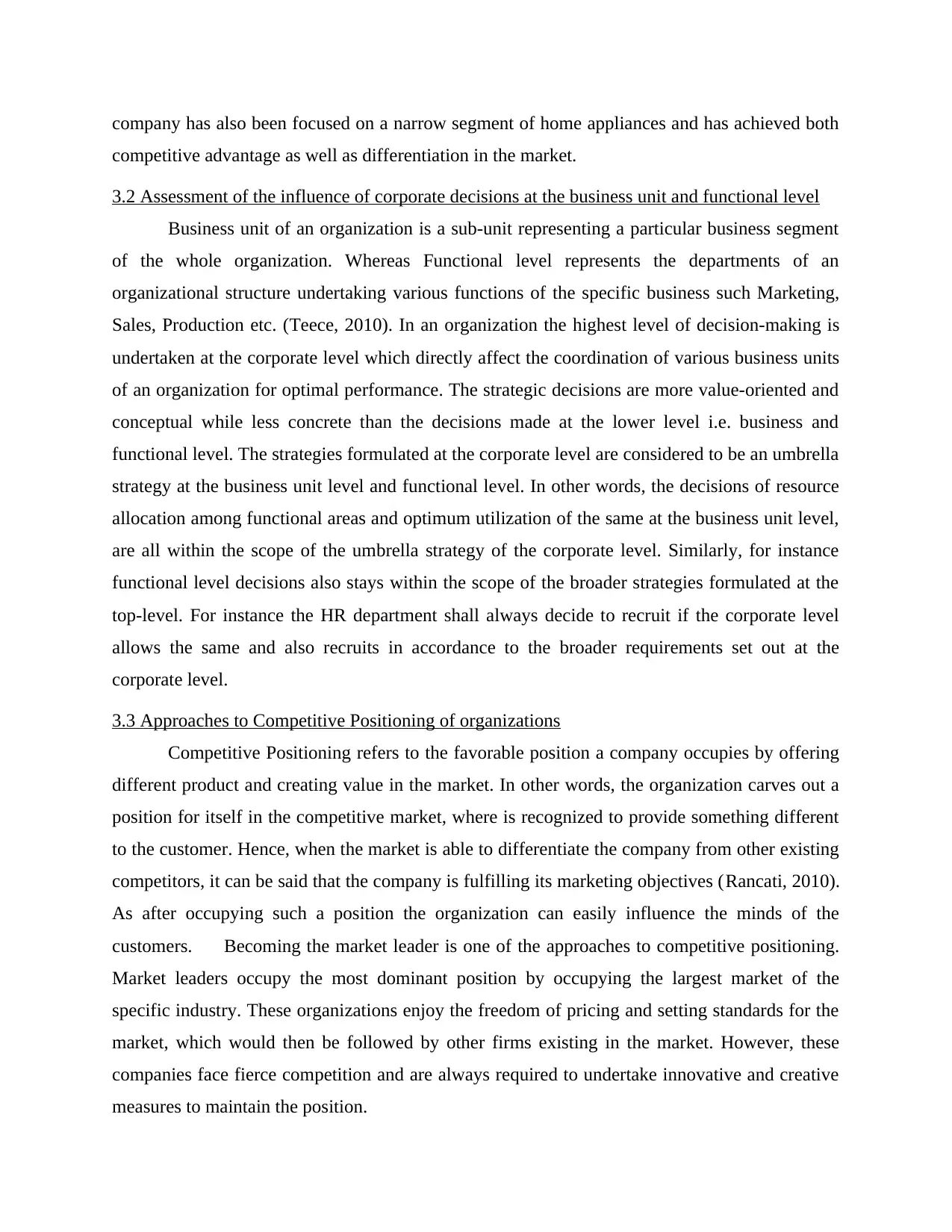
company has also been focused on a narrow segment of home appliances and has achieved both
competitive advantage as well as differentiation in the market.
3.2 Assessment of the influence of corporate decisions at the business unit and functional level
Business unit of an organization is a sub-unit representing a particular business segment
of the whole organization. Whereas Functional level represents the departments of an
organizational structure undertaking various functions of the specific business such Marketing,
Sales, Production etc. (Teece, 2010). In an organization the highest level of decision-making is
undertaken at the corporate level which directly affect the coordination of various business units
of an organization for optimal performance. The strategic decisions are more value-oriented and
conceptual while less concrete than the decisions made at the lower level i.e. business and
functional level. The strategies formulated at the corporate level are considered to be an umbrella
strategy at the business unit level and functional level. In other words, the decisions of resource
allocation among functional areas and optimum utilization of the same at the business unit level,
are all within the scope of the umbrella strategy of the corporate level. Similarly, for instance
functional level decisions also stays within the scope of the broader strategies formulated at the
top-level. For instance the HR department shall always decide to recruit if the corporate level
allows the same and also recruits in accordance to the broader requirements set out at the
corporate level.
3.3 Approaches to Competitive Positioning of organizations
Competitive Positioning refers to the favorable position a company occupies by offering
different product and creating value in the market. In other words, the organization carves out a
position for itself in the competitive market, where is recognized to provide something different
to the customer. Hence, when the market is able to differentiate the company from other existing
competitors, it can be said that the company is fulfilling its marketing objectives (Rancati, 2010).
As after occupying such a position the organization can easily influence the minds of the
customers. Becoming the market leader is one of the approaches to competitive positioning.
Market leaders occupy the most dominant position by occupying the largest market of the
specific industry. These organizations enjoy the freedom of pricing and setting standards for the
market, which would then be followed by other firms existing in the market. However, these
companies face fierce competition and are always required to undertake innovative and creative
measures to maintain the position.
competitive advantage as well as differentiation in the market.
3.2 Assessment of the influence of corporate decisions at the business unit and functional level
Business unit of an organization is a sub-unit representing a particular business segment
of the whole organization. Whereas Functional level represents the departments of an
organizational structure undertaking various functions of the specific business such Marketing,
Sales, Production etc. (Teece, 2010). In an organization the highest level of decision-making is
undertaken at the corporate level which directly affect the coordination of various business units
of an organization for optimal performance. The strategic decisions are more value-oriented and
conceptual while less concrete than the decisions made at the lower level i.e. business and
functional level. The strategies formulated at the corporate level are considered to be an umbrella
strategy at the business unit level and functional level. In other words, the decisions of resource
allocation among functional areas and optimum utilization of the same at the business unit level,
are all within the scope of the umbrella strategy of the corporate level. Similarly, for instance
functional level decisions also stays within the scope of the broader strategies formulated at the
top-level. For instance the HR department shall always decide to recruit if the corporate level
allows the same and also recruits in accordance to the broader requirements set out at the
corporate level.
3.3 Approaches to Competitive Positioning of organizations
Competitive Positioning refers to the favorable position a company occupies by offering
different product and creating value in the market. In other words, the organization carves out a
position for itself in the competitive market, where is recognized to provide something different
to the customer. Hence, when the market is able to differentiate the company from other existing
competitors, it can be said that the company is fulfilling its marketing objectives (Rancati, 2010).
As after occupying such a position the organization can easily influence the minds of the
customers. Becoming the market leader is one of the approaches to competitive positioning.
Market leaders occupy the most dominant position by occupying the largest market of the
specific industry. These organizations enjoy the freedom of pricing and setting standards for the
market, which would then be followed by other firms existing in the market. However, these
companies face fierce competition and are always required to undertake innovative and creative
measures to maintain the position.
Paraphrase This Document
Need a fresh take? Get an instant paraphrase of this document with our AI Paraphraser
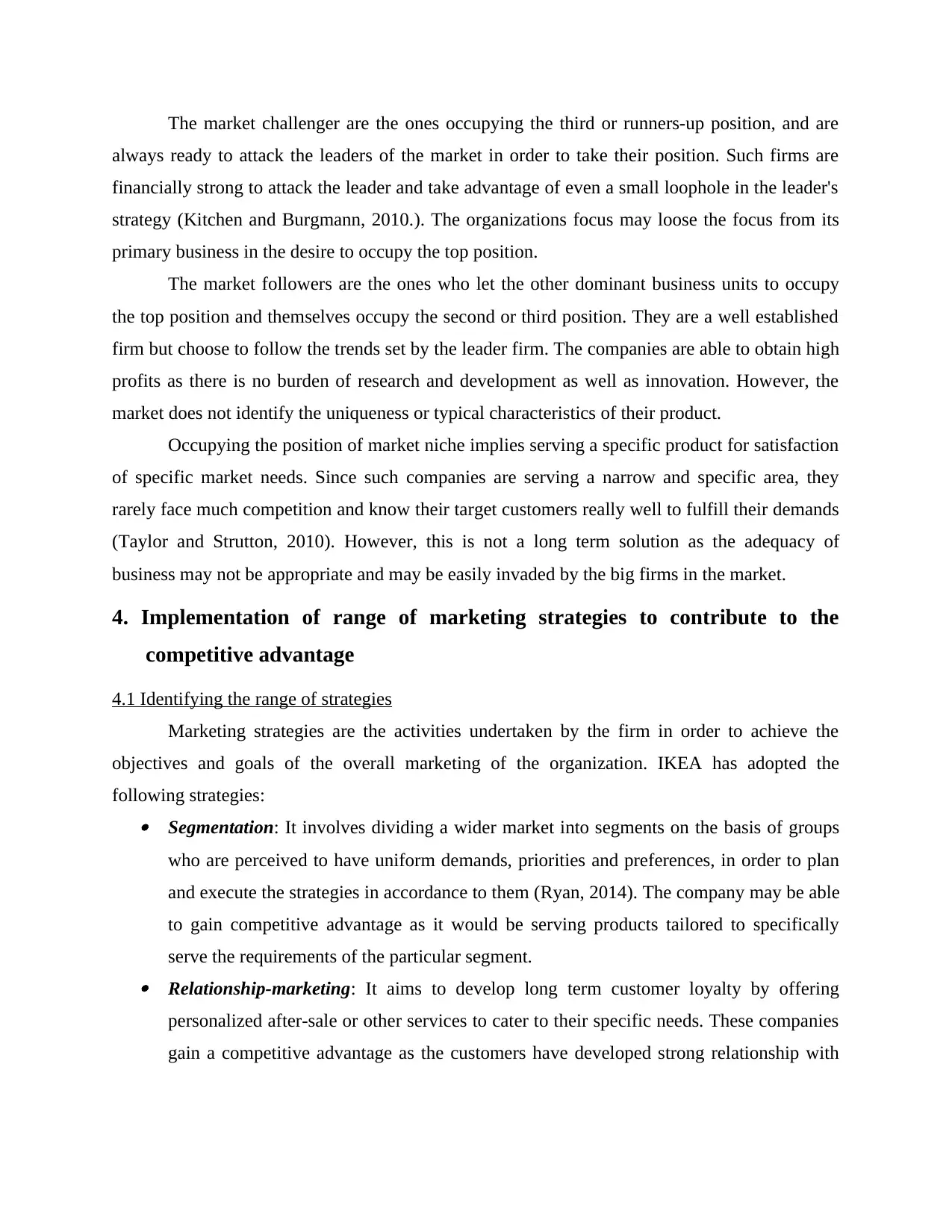
The market challenger are the ones occupying the third or runners-up position, and are
always ready to attack the leaders of the market in order to take their position. Such firms are
financially strong to attack the leader and take advantage of even a small loophole in the leader's
strategy (Kitchen and Burgmann, 2010.). The organizations focus may loose the focus from its
primary business in the desire to occupy the top position.
The market followers are the ones who let the other dominant business units to occupy
the top position and themselves occupy the second or third position. They are a well established
firm but choose to follow the trends set by the leader firm. The companies are able to obtain high
profits as there is no burden of research and development as well as innovation. However, the
market does not identify the uniqueness or typical characteristics of their product.
Occupying the position of market niche implies serving a specific product for satisfaction
of specific market needs. Since such companies are serving a narrow and specific area, they
rarely face much competition and know their target customers really well to fulfill their demands
(Taylor and Strutton, 2010). However, this is not a long term solution as the adequacy of
business may not be appropriate and may be easily invaded by the big firms in the market.
4. Implementation of range of marketing strategies to contribute to the
competitive advantage
4.1 Identifying the range of strategies
Marketing strategies are the activities undertaken by the firm in order to achieve the
objectives and goals of the overall marketing of the organization. IKEA has adopted the
following strategies: Segmentation: It involves dividing a wider market into segments on the basis of groups
who are perceived to have uniform demands, priorities and preferences, in order to plan
and execute the strategies in accordance to them (Ryan, 2014). The company may be able
to gain competitive advantage as it would be serving products tailored to specifically
serve the requirements of the particular segment. Relationship-marketing: It aims to develop long term customer loyalty by offering
personalized after-sale or other services to cater to their specific needs. These companies
gain a competitive advantage as the customers have developed strong relationship with
always ready to attack the leaders of the market in order to take their position. Such firms are
financially strong to attack the leader and take advantage of even a small loophole in the leader's
strategy (Kitchen and Burgmann, 2010.). The organizations focus may loose the focus from its
primary business in the desire to occupy the top position.
The market followers are the ones who let the other dominant business units to occupy
the top position and themselves occupy the second or third position. They are a well established
firm but choose to follow the trends set by the leader firm. The companies are able to obtain high
profits as there is no burden of research and development as well as innovation. However, the
market does not identify the uniqueness or typical characteristics of their product.
Occupying the position of market niche implies serving a specific product for satisfaction
of specific market needs. Since such companies are serving a narrow and specific area, they
rarely face much competition and know their target customers really well to fulfill their demands
(Taylor and Strutton, 2010). However, this is not a long term solution as the adequacy of
business may not be appropriate and may be easily invaded by the big firms in the market.
4. Implementation of range of marketing strategies to contribute to the
competitive advantage
4.1 Identifying the range of strategies
Marketing strategies are the activities undertaken by the firm in order to achieve the
objectives and goals of the overall marketing of the organization. IKEA has adopted the
following strategies: Segmentation: It involves dividing a wider market into segments on the basis of groups
who are perceived to have uniform demands, priorities and preferences, in order to plan
and execute the strategies in accordance to them (Ryan, 2014). The company may be able
to gain competitive advantage as it would be serving products tailored to specifically
serve the requirements of the particular segment. Relationship-marketing: It aims to develop long term customer loyalty by offering
personalized after-sale or other services to cater to their specific needs. These companies
gain a competitive advantage as the customers have developed strong relationship with
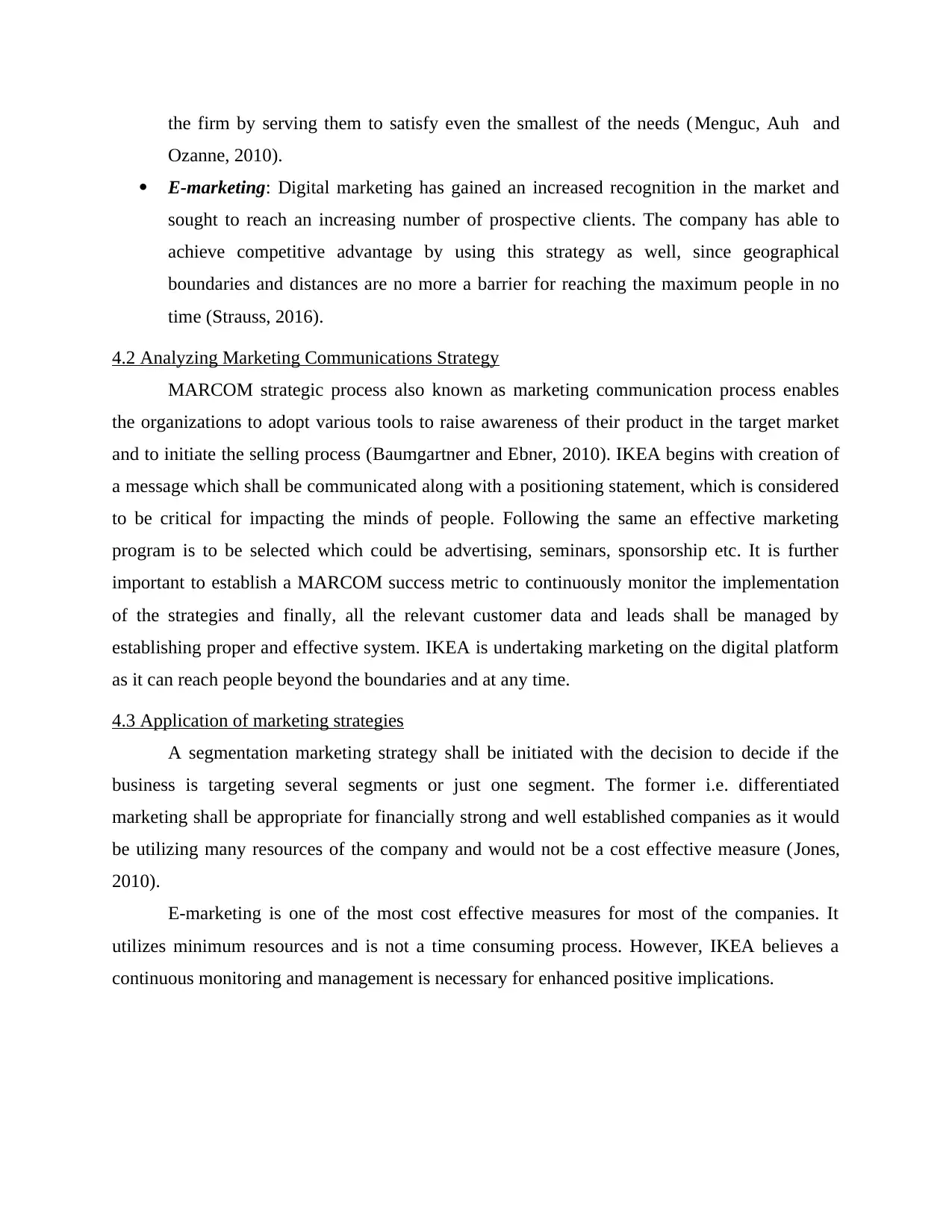
the firm by serving them to satisfy even the smallest of the needs (Menguc, Auh and
Ozanne, 2010).
E-marketing: Digital marketing has gained an increased recognition in the market and
sought to reach an increasing number of prospective clients. The company has able to
achieve competitive advantage by using this strategy as well, since geographical
boundaries and distances are no more a barrier for reaching the maximum people in no
time (Strauss, 2016).
4.2 Analyzing Marketing Communications Strategy
MARCOM strategic process also known as marketing communication process enables
the organizations to adopt various tools to raise awareness of their product in the target market
and to initiate the selling process (Baumgartner and Ebner, 2010). IKEA begins with creation of
a message which shall be communicated along with a positioning statement, which is considered
to be critical for impacting the minds of people. Following the same an effective marketing
program is to be selected which could be advertising, seminars, sponsorship etc. It is further
important to establish a MARCOM success metric to continuously monitor the implementation
of the strategies and finally, all the relevant customer data and leads shall be managed by
establishing proper and effective system. IKEA is undertaking marketing on the digital platform
as it can reach people beyond the boundaries and at any time.
4.3 Application of marketing strategies
A segmentation marketing strategy shall be initiated with the decision to decide if the
business is targeting several segments or just one segment. The former i.e. differentiated
marketing shall be appropriate for financially strong and well established companies as it would
be utilizing many resources of the company and would not be a cost effective measure (Jones,
2010).
E-marketing is one of the most cost effective measures for most of the companies. It
utilizes minimum resources and is not a time consuming process. However, IKEA believes a
continuous monitoring and management is necessary for enhanced positive implications.
Ozanne, 2010).
E-marketing: Digital marketing has gained an increased recognition in the market and
sought to reach an increasing number of prospective clients. The company has able to
achieve competitive advantage by using this strategy as well, since geographical
boundaries and distances are no more a barrier for reaching the maximum people in no
time (Strauss, 2016).
4.2 Analyzing Marketing Communications Strategy
MARCOM strategic process also known as marketing communication process enables
the organizations to adopt various tools to raise awareness of their product in the target market
and to initiate the selling process (Baumgartner and Ebner, 2010). IKEA begins with creation of
a message which shall be communicated along with a positioning statement, which is considered
to be critical for impacting the minds of people. Following the same an effective marketing
program is to be selected which could be advertising, seminars, sponsorship etc. It is further
important to establish a MARCOM success metric to continuously monitor the implementation
of the strategies and finally, all the relevant customer data and leads shall be managed by
establishing proper and effective system. IKEA is undertaking marketing on the digital platform
as it can reach people beyond the boundaries and at any time.
4.3 Application of marketing strategies
A segmentation marketing strategy shall be initiated with the decision to decide if the
business is targeting several segments or just one segment. The former i.e. differentiated
marketing shall be appropriate for financially strong and well established companies as it would
be utilizing many resources of the company and would not be a cost effective measure (Jones,
2010).
E-marketing is one of the most cost effective measures for most of the companies. It
utilizes minimum resources and is not a time consuming process. However, IKEA believes a
continuous monitoring and management is necessary for enhanced positive implications.
You're viewing a preview
Unlock full access by subscribing today!
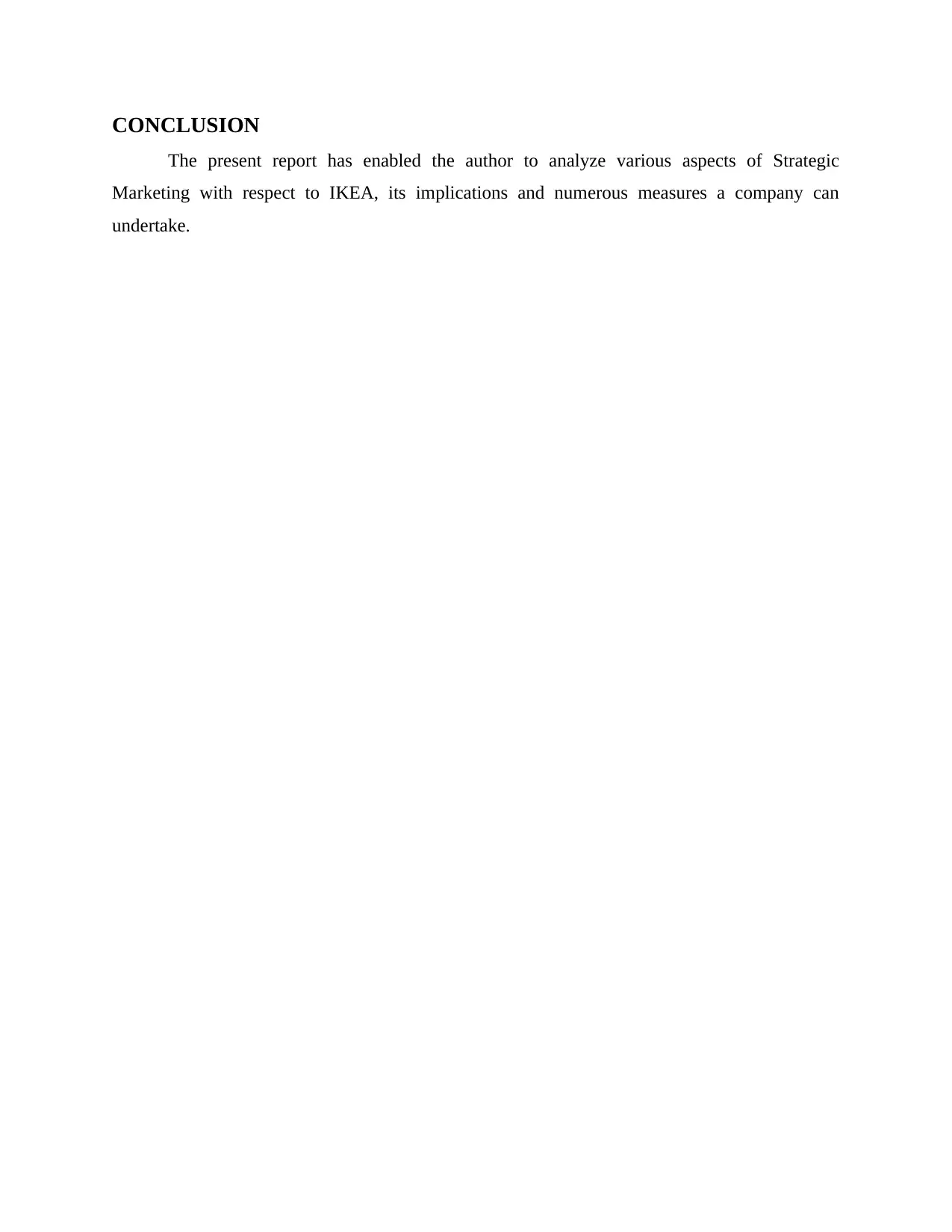
CONCLUSION
The present report has enabled the author to analyze various aspects of Strategic
Marketing with respect to IKEA, its implications and numerous measures a company can
undertake.
The present report has enabled the author to analyze various aspects of Strategic
Marketing with respect to IKEA, its implications and numerous measures a company can
undertake.
Paraphrase This Document
Need a fresh take? Get an instant paraphrase of this document with our AI Paraphraser
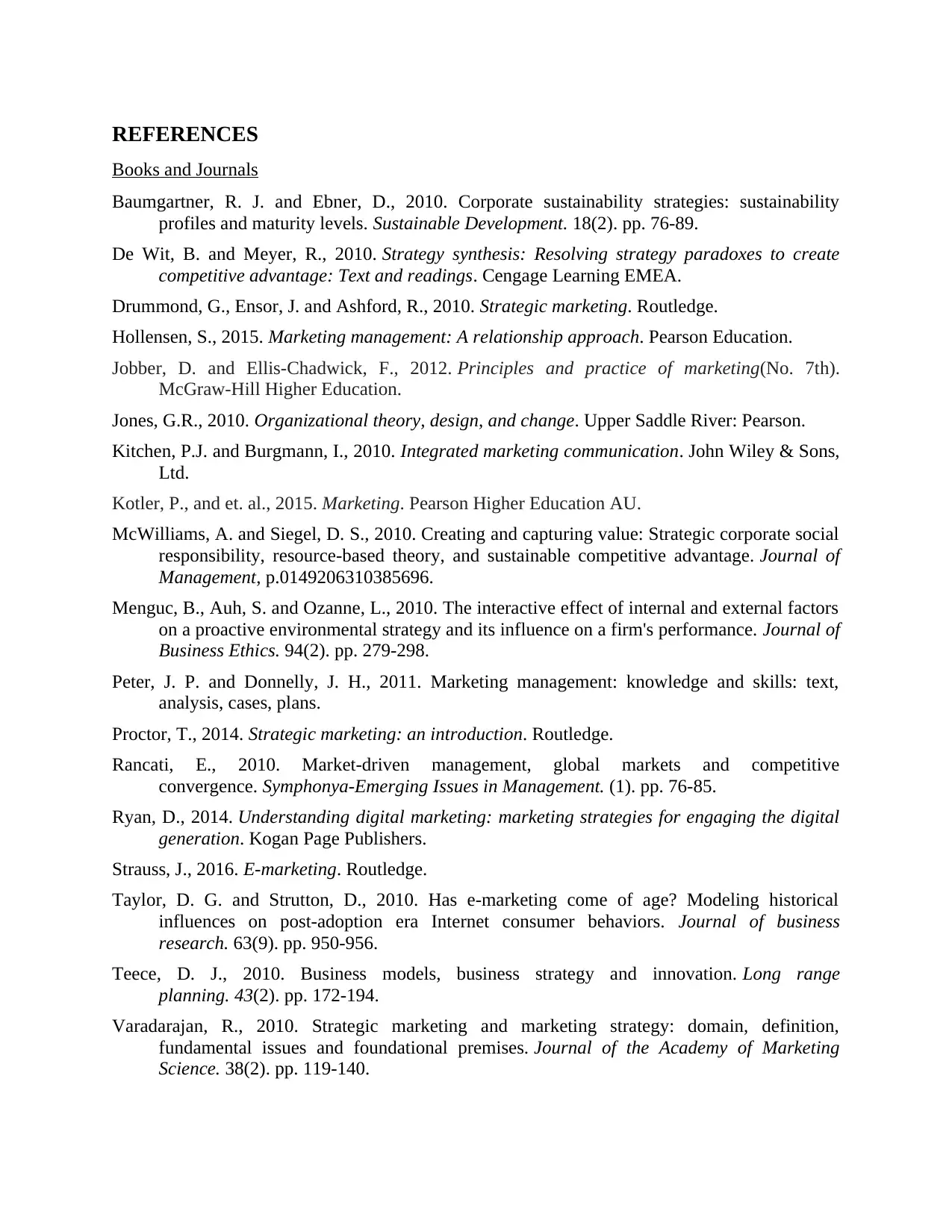
REFERENCES
Books and Journals
Baumgartner, R. J. and Ebner, D., 2010. Corporate sustainability strategies: sustainability
profiles and maturity levels. Sustainable Development. 18(2). pp. 76-89.
De Wit, B. and Meyer, R., 2010. Strategy synthesis: Resolving strategy paradoxes to create
competitive advantage: Text and readings. Cengage Learning EMEA.
Drummond, G., Ensor, J. and Ashford, R., 2010. Strategic marketing. Routledge.
Hollensen, S., 2015. Marketing management: A relationship approach. Pearson Education.
Jobber, D. and Ellis-Chadwick, F., 2012. Principles and practice of marketing(No. 7th).
McGraw-Hill Higher Education.
Jones, G.R., 2010. Organizational theory, design, and change. Upper Saddle River: Pearson.
Kitchen, P.J. and Burgmann, I., 2010. Integrated marketing communication. John Wiley & Sons,
Ltd.
Kotler, P., and et. al., 2015. Marketing. Pearson Higher Education AU.
McWilliams, A. and Siegel, D. S., 2010. Creating and capturing value: Strategic corporate social
responsibility, resource-based theory, and sustainable competitive advantage. Journal of
Management, p.0149206310385696.
Menguc, B., Auh, S. and Ozanne, L., 2010. The interactive effect of internal and external factors
on a proactive environmental strategy and its influence on a firm's performance. Journal of
Business Ethics. 94(2). pp. 279-298.
Peter, J. P. and Donnelly, J. H., 2011. Marketing management: knowledge and skills: text,
analysis, cases, plans.
Proctor, T., 2014. Strategic marketing: an introduction. Routledge.
Rancati, E., 2010. Market-driven management, global markets and competitive
convergence. Symphonya-Emerging Issues in Management. (1). pp. 76-85.
Ryan, D., 2014. Understanding digital marketing: marketing strategies for engaging the digital
generation. Kogan Page Publishers.
Strauss, J., 2016. E-marketing. Routledge.
Taylor, D. G. and Strutton, D., 2010. Has e-marketing come of age? Modeling historical
influences on post-adoption era Internet consumer behaviors. Journal of business
research. 63(9). pp. 950-956.
Teece, D. J., 2010. Business models, business strategy and innovation. Long range
planning. 43(2). pp. 172-194.
Varadarajan, R., 2010. Strategic marketing and marketing strategy: domain, definition,
fundamental issues and foundational premises. Journal of the Academy of Marketing
Science. 38(2). pp. 119-140.
Books and Journals
Baumgartner, R. J. and Ebner, D., 2010. Corporate sustainability strategies: sustainability
profiles and maturity levels. Sustainable Development. 18(2). pp. 76-89.
De Wit, B. and Meyer, R., 2010. Strategy synthesis: Resolving strategy paradoxes to create
competitive advantage: Text and readings. Cengage Learning EMEA.
Drummond, G., Ensor, J. and Ashford, R., 2010. Strategic marketing. Routledge.
Hollensen, S., 2015. Marketing management: A relationship approach. Pearson Education.
Jobber, D. and Ellis-Chadwick, F., 2012. Principles and practice of marketing(No. 7th).
McGraw-Hill Higher Education.
Jones, G.R., 2010. Organizational theory, design, and change. Upper Saddle River: Pearson.
Kitchen, P.J. and Burgmann, I., 2010. Integrated marketing communication. John Wiley & Sons,
Ltd.
Kotler, P., and et. al., 2015. Marketing. Pearson Higher Education AU.
McWilliams, A. and Siegel, D. S., 2010. Creating and capturing value: Strategic corporate social
responsibility, resource-based theory, and sustainable competitive advantage. Journal of
Management, p.0149206310385696.
Menguc, B., Auh, S. and Ozanne, L., 2010. The interactive effect of internal and external factors
on a proactive environmental strategy and its influence on a firm's performance. Journal of
Business Ethics. 94(2). pp. 279-298.
Peter, J. P. and Donnelly, J. H., 2011. Marketing management: knowledge and skills: text,
analysis, cases, plans.
Proctor, T., 2014. Strategic marketing: an introduction. Routledge.
Rancati, E., 2010. Market-driven management, global markets and competitive
convergence. Symphonya-Emerging Issues in Management. (1). pp. 76-85.
Ryan, D., 2014. Understanding digital marketing: marketing strategies for engaging the digital
generation. Kogan Page Publishers.
Strauss, J., 2016. E-marketing. Routledge.
Taylor, D. G. and Strutton, D., 2010. Has e-marketing come of age? Modeling historical
influences on post-adoption era Internet consumer behaviors. Journal of business
research. 63(9). pp. 950-956.
Teece, D. J., 2010. Business models, business strategy and innovation. Long range
planning. 43(2). pp. 172-194.
Varadarajan, R., 2010. Strategic marketing and marketing strategy: domain, definition,
fundamental issues and foundational premises. Journal of the Academy of Marketing
Science. 38(2). pp. 119-140.
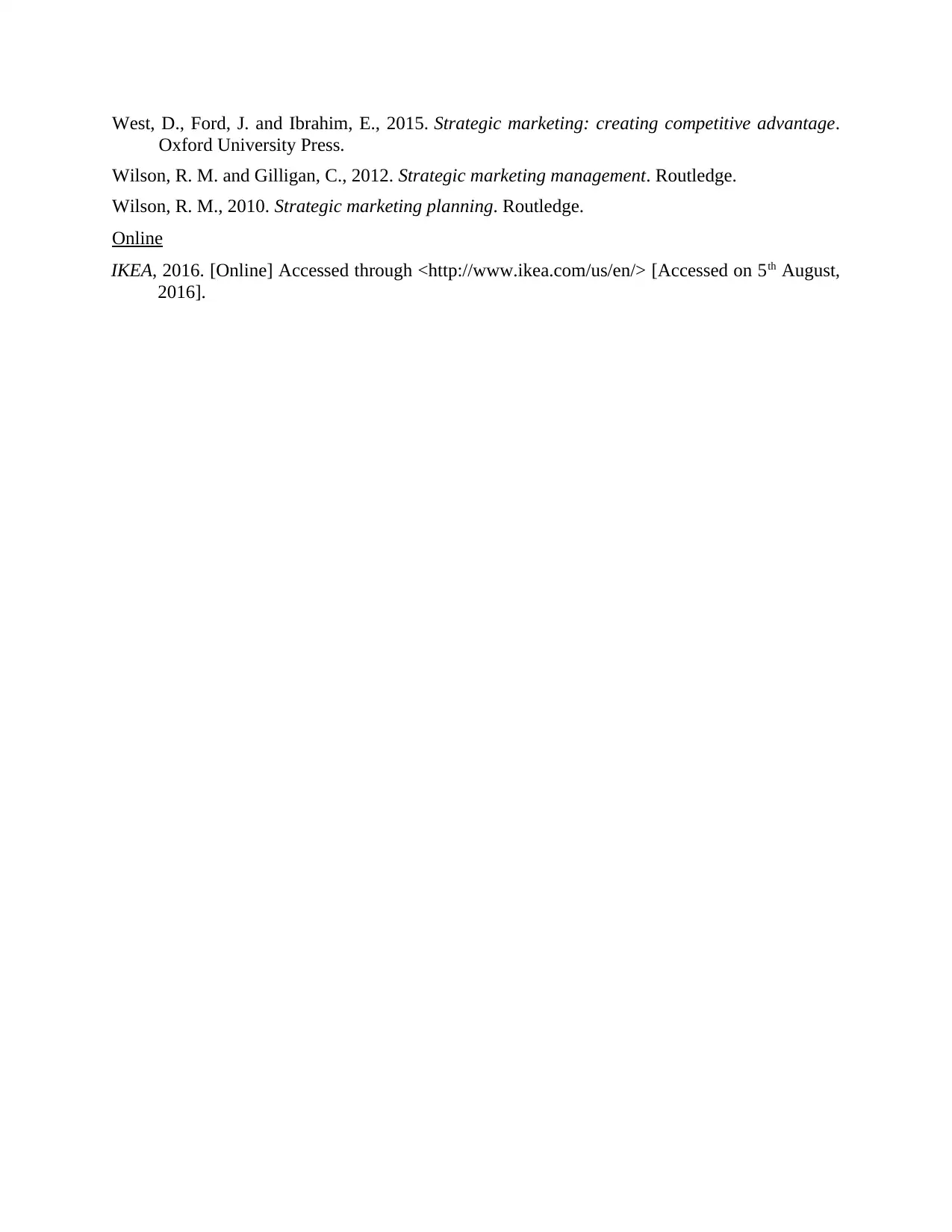
West, D., Ford, J. and Ibrahim, E., 2015. Strategic marketing: creating competitive advantage.
Oxford University Press.
Wilson, R. M. and Gilligan, C., 2012. Strategic marketing management. Routledge.
Wilson, R. M., 2010. Strategic marketing planning. Routledge.
Online
IKEA, 2016. [Online] Accessed through <http://www.ikea.com/us/en/> [Accessed on 5th August,
2016].
Oxford University Press.
Wilson, R. M. and Gilligan, C., 2012. Strategic marketing management. Routledge.
Wilson, R. M., 2010. Strategic marketing planning. Routledge.
Online
IKEA, 2016. [Online] Accessed through <http://www.ikea.com/us/en/> [Accessed on 5th August,
2016].
You're viewing a preview
Unlock full access by subscribing today!

1 out of 16
Related Documents
Your All-in-One AI-Powered Toolkit for Academic Success.
+13062052269
info@desklib.com
Available 24*7 on WhatsApp / Email
![[object Object]](/_next/static/media/star-bottom.7253800d.svg)
Unlock your academic potential
© 2024 | Zucol Services PVT LTD | All rights reserved.





